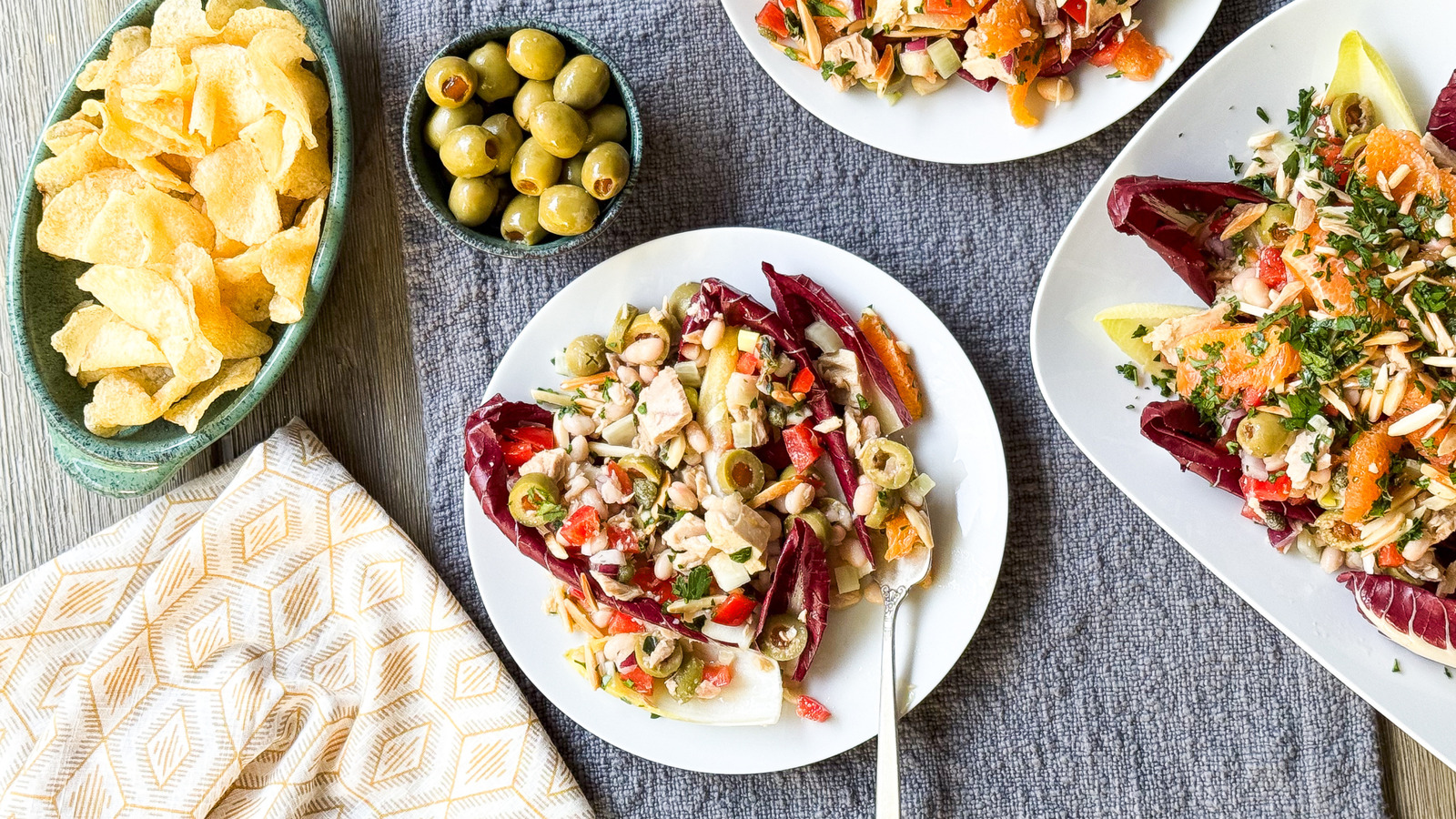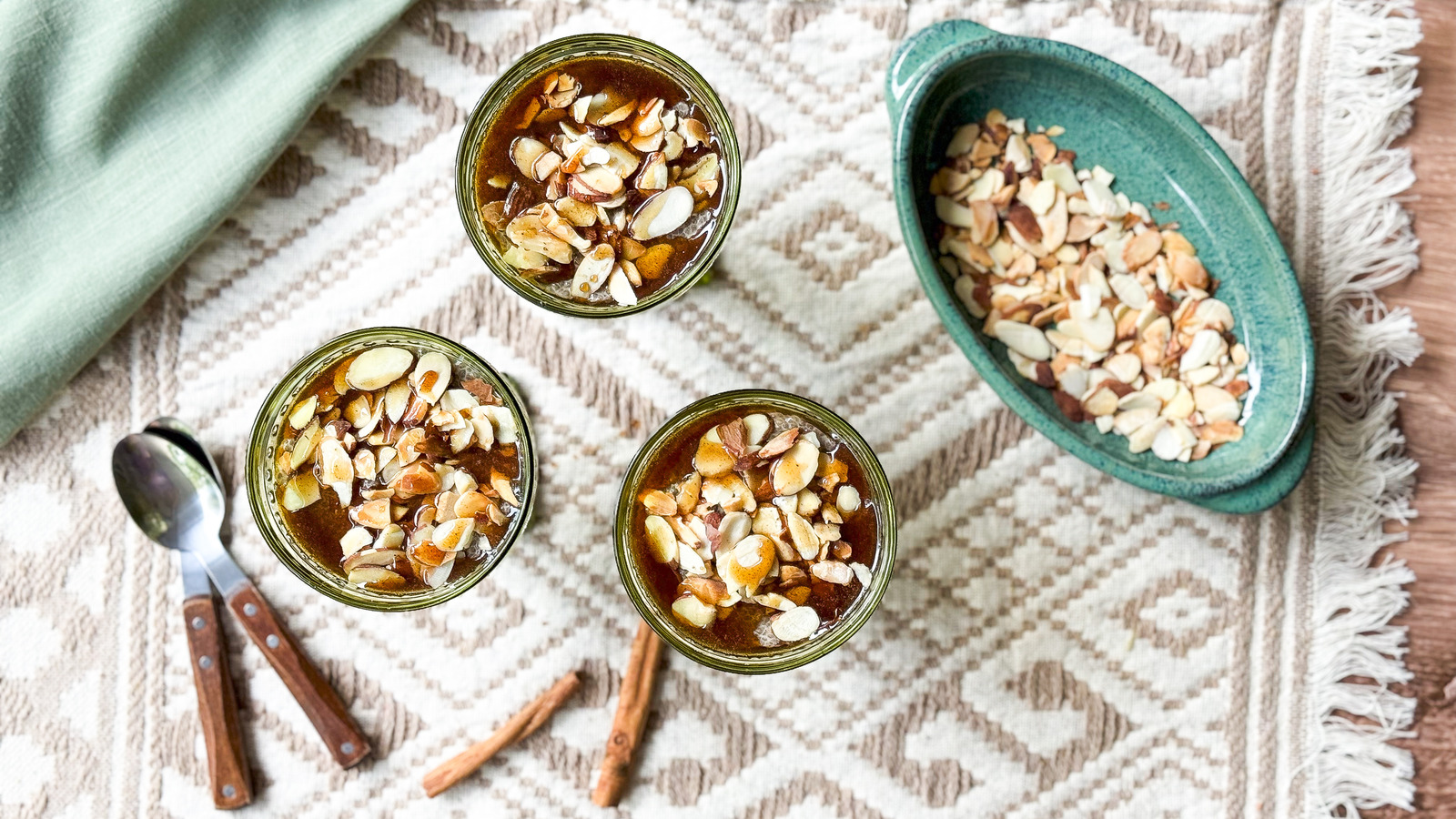
Spanish-Impressed Tuna Salad With White Beans And Oranges Recipe
[ad_1]
Julie Kinnaird/Chowhound
If the phrases “tuna salad” conjure unfavorable pictures of mayonnaise-laden and monochromatic canned fish, this Spanish-inspired tuna salad with white beans and oranges provides you a complete new appreciation for the dish. Recipe developer Julie Kinnaird shares her interpretation of tuna salads that she tasted all by way of Spain. Kinnaird says that in Spain, tuna salad is usually served alongside grilled fish and roasted potatoes, nevertheless it might even be the star of the meal with a aspect of crusty bread. Kinnaird notably cherished a Valencia-style salad she had in Madrid, which was garnished with a great deal of juicy current orange segments.
Spanish tuna salads generally attribute white tuna packed in olive oil, numerous olives, onion, greens, cooked beans, boiled eggs, and potatoes. Kinnaird’s mannequin choices all of her favorite components, using pimento-stuffed olives, current fennel, pink peppers, onion, capers, crunchy toasted almonds, creamy white beans, and the nice, juicy oranges. She makes a salad dressing with the juice of the oranges, good-quality Spanish olive oil, sherry wine vinegar for a signature fashion, and up to date oregano. The salad is stuffed with shade and style, and it appears beautiful when it’s served on a platter.
Accumulate the elements for Spanish-inspired tuna salad with white beans and oranges
For this recipe, Kinnaird makes use of her favorite canned Spanish tuna packed in olive oil, which is produced by Ortiz. Any good-quality white tuna packed in olive oil could possibly be a suitable substitute. The tuna is tossed with chopped pink onion, sweet pink bell pepper, current fennel bulb, sliced Manzanilla olives with pimentos tucked inside, and capers with somewhat little bit of their brine. Canned white navy beans (or totally different small white bean varieties) add a creamy texture to the salad — merely be sure that to rinse them first.
For the salad dressing, it will be greatest to make use of a good-quality Spanish extra-virgin olive oil (for authenticity), sherry vinegar, chopped garlic, and up to date oregano. Juice from Valencia oranges (or totally different comparable varieties) is collected in order so as to add to the dressing when eradicating the segments from the peel and membranes. Because of the olives and capers with brine are pretty salty, you’ll not need further salt for this recipe, till you might need a non-public selection. The salad is accomplished with toasted slivered almonds and up to date chopped Italian parsley, and it’s served on a mattress of pink and white Belgian endive leaves.
Step 1: Slice the olives
Slice the olives into rounds.
Step 2: Scale back the ends off of the oranges
Scale back the ends from every oranges to disclose the flesh.
Step 3: Scale back the peel away from the oranges
Stand the orange on one flat end on a decreasing board and punctiliously scale back the peel and pith away from the flesh.
Step 4: Launch the orange segments from the membranes
Use a sharp knife to cut between the membranes and launch the segments and juice proper right into a bowl, squeezing out the extra juice from the membranes and peels. Change the segments to a separate bowl.
Step 5: Make the dressing
Whisk the olive oil, sherry vinegar, garlic, and oregano into the orange juice to make the dressing. Put apart.
Step 6: Combine the salad elements
In a giant bowl, combine the sliced olives, beans, fennel, capers, caper brine, pink pepper, and onion. Add the tuna and oil from each can.
Step 7: Add the dressing
Add ⅓ cup of the dressing to the tuna mixture.
Step 8: Toss the salad
Toss gently to combine and put apart.
Step 9: Add the almonds to a skillet
Add the almonds to a small skillet over medium heat.
Step 10: Toast the almonds
Toast the almonds, stirring constantly, until golden brown (about 5 minutes). Take away from the skillet to relax.
Step 11: Put together the endive leaves on a platter
To assemble the salad, put together the endive leaves on a giant platter or shallow serving bowl.
Step 12: Add the tuna salad
Mound the tuna salad mixture on prime of the endive.
Step 13: Add the orange segments
Add the reserved orange segments.
Step 14: Add the almonds and parsley
Sprinkle on the toasted almonds and chopped parsley.
Step 15: Drizzle on the remaining dressing
Finish by drizzling on the remaining dressing.
Step 16: Serve the Spanish-inspired tuna salad with white beans and oranges
Serve the Spanish-inspired tuna salad with white beans and oranges immediately.
Spanish-Impressed Tuna Salad With White Beans and Oranges Recipe
This Spanish-inspired tuna salad is vibrant and up to date. A mixture of citrus, herbs, beans, and aromatic greens give this party-perfect dish its style.
- ½ cup pimiento-stuffed Spanish olives, drained
- 2 Valencia or navel oranges
- 3 tablespoons Spanish olive oil
- 2 tablespoons sherry vinegar
- 1 small clove garlic, minced
- 1 tablespoon chopped current oregano
- 1 (15-ounce) can small white beans (navy or good northern), drained and rinsed
- 1 small bulb fennel, stem and inexperienced stalks eradicated, chopped
- 2 tablespoons capers
- 1 tablespoon caper brine
- 1 small pink bell pepper, stem, ribs and seeds eradicated, chopped
- ¼ cup chopped pink onion
- 2 (4-ounce) cans Spanish tuna in olive oil
- ½ cup slivered raw almonds
- ¼ cup chopped current Italian parsley
- 2 small heads Belgian endive (1 pink, 1 white), trimmed and leaves separated
- Slice the olives into rounds.
- Scale back the ends from every oranges to disclose the flesh.
- Stand the orange on one flat end on a decreasing board and punctiliously scale back the peel and pith away from the flesh.
- Use a sharp knife to cut between the membranes and launch the segments and juice proper right into a bowl, squeezing out the extra juice from the membranes and peels. Change the segments to a separate bowl.
- Whisk the olive oil, sherry vinegar, garlic, and oregano into the orange juice to make the dressing. Put apart.
- In a giant bowl, combine the sliced olives, beans, fennel, capers, caper brine, pink pepper, and onion. Add the tuna and oil from each can.
- Add ⅓ cup of the dressing to the tuna mixture.
- Toss gently to combine and put apart.
- Add the almonds to a small skillet over medium heat.
- Toast the almonds, stirring constantly, until golden brown (about 5 minutes). Take away from the skillet to relax.
- To assemble the salad, put together the endive leaves on a giant platter or shallow serving bowl.
- Mound the tuna salad mixture on prime of the endive.
- Add the reserved orange segments.
- Sprinkle on the toasted almonds and chopped parsley.
- Finish by drizzling on the remaining dressing.
- Serve the Spanish-inspired tuna salad with white beans and oranges immediately.
What sort of tuna is biggest for a tuna salad?
In case you’ve shopped for tuna these days, you might need seen that the canned fish aisle on the grocery retailer is not what it was! There seems to be a tremendous number of tuna varieties and kinds to pick out from. There’s oil-packed, water-packed, salted, marinated, or sodium-free. There’s moreover the question of which type of tuna is basically essentially the most eco-friendly.
Albacore, or “white,” tuna is a preferable different for making tuna salad by means of style, food plan, and ethics. Albacore is not overly fishy tasting and has a company texture that won’t develop into mushy everytime you mix it. Albacore moreover has further omega-3 fatty acids than others throughout the tuna family. It is a sustainable selection that is not in peril of being over-fished. Kinnaird says that she has been consuming Ortiz olive oil-packed tuna for years resulting from its superior top quality and style. Conservas Ortiz has canning origins in Spain from 1891, and the company was formally created in 1956. Ortiz has historically had a dedication to top quality and standard fishing methods, and all of the tuna is caught by hand. The white tuna Ortiz makes use of in its merchandise is Bonito Del Norte, which is taken into consideration to be most likely the best tunas in Spain.
What’s the distinction between frequent and Spanish olive oil?
When most people take into account olive oil, they take into account Italy, which is famous for using the oil in all sides of cooking. However, surprisingly, Spain takes the very best honors. The nation produced over 5.9 million tons of olive oil in 2023, which was almost double Italy’s manufacturing! Olives have been a part of Spanish delicacies for tons of of years, and the nation has been producing olive oil given that time of the Roman Empire. Spain’s native climate is ideal for olive manufacturing, and it is home to spherical 350 million olive timber. Andalusia in southern Spain produces further olive oil than anyplace else on the planet.
So, what makes Spanish olive oil fully totally different from totally different nations’? Spanish olive oil could possibly be very high quality and generally has a fruitier fashion than totally different varieties because of greatest rising circumstances. Spanish olive oil will differ from space to space in fashion and shade, counting on which type of olives are chosen. In Andalusia, hojiblanca olives are used, which give the oil a grassy fashion. In Central Spain, Cornicabra olives are further widespread and offers the oil a further bitter edge. Basic, you presumably can rely on Spanish olive oil for prime marks in top quality and depth of style.
[ad_2]


